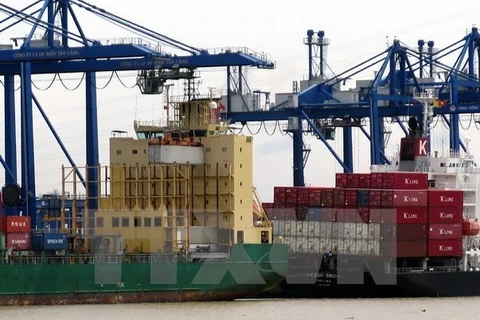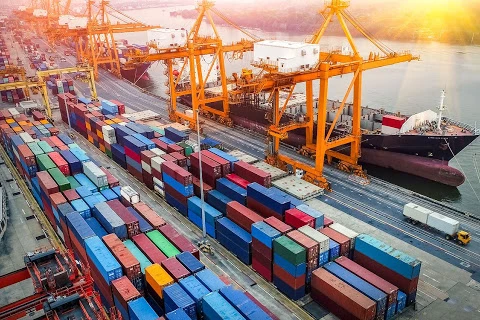 Trade between Vietnam and the EU is expected to achieve a high growth rate after the EVFTA is implemented. (Photo: Duc Duy/Vietnam +)
Trade between Vietnam and the EU is expected to achieve a high growth rate after the EVFTA is implemented. (Photo: Duc Duy/Vietnam +) With the highest and most comprehensive commitments among the previous free trade agreements (FTAs) of Vietnam, the EVFTA is expected to have a profound impact on the Vietnamese economy in the future.
In particular, the commitment to strong market openings in the EVFTA agreement will be a huge push for Vietnam's export growth, helping to diversify markets and export products, enable agricultural and aquatic products as well as other Vietnamese products to have a competitive advantage.
A boost in goods exports
According to a report by the Ministry of Industry and Trade in response to questions from the National Assembly deputies at the ninth session of the 14th National Assembly, the COVID-19 pandemic had a strong influence on the production and import-export situation of not only Vietnam but all over the world.
The implementation of the EVFTA is important to help offset the economic slowdown during the pandemic. From the business perspective, the EVFTA is confirmed to bring more diversified market opportunities to businesses, helping them regain post-pandemic growth momentum.
Mr. Luong Hoang Thai, director of the Multilateral Trade Policy Department at the Ministry of Industry and Trade, said that when the EVFTA is implemented, it will be an important boost for Vietnam's exports to this market of more than 500 million people.
Also according to the report of the Ministry of Industry and Trade, in terms of exports alone, the EVFTA is expected to increase Vietnam's exports to the EU by about 42.7 percent in 2025 and 44.37 percent in 2030.
From another perspective, according to Tran Thanh Hai, Deputy Director of the Import and Export Department under the Ministry of Industry and Trade, the implementation of the EVFTA is a long-term strategy to help Vietnamese enterprises, especially small and medium ones, to integrate deeply in the regional value chain, improve export production capacity and competitiveness.
The EU is the second largest import market in the world. Every year, the EU imports about 2,338 billion USD, while Vietnam's export proportion in the EU is about 2% with just over 42% of Vietnam's exports to the EU enjoying 0% tax rate under the GSP program.
Hai said that, with strong market opening commitments, and the commitment to abolishing import duties by up to nearly 100% on tariffs in the EVFTA, the opportunity to increase Vietnam’s exports is significant. Especially when Vietnam has essentially controlled the COVID-19 translation. Therefore, the Vietnamese business community has greater opportunities and is more proactive than businesses in many other countries that are still facing developments of the pandemic.
Regarding imports, Vietnamese businesses will also benefit from imported goods and raw materials with good quality and stability and more reasonable prices from the EU.
Thus, in the post-epidemic period, if the EVFTA is put into effect, Vietnamese enterprises have a great advantage in reducing or removing tariff barriers to the EU market to exploit this 18 trillion USD market.
Creating a competitive advantage
EVFTA provides three methods to determine the origin of a good, including: pure origin goods; substantial processed or processed goods and product specific rules (PSR).
In addition, the aggregation rule allows Vietnam and EU countries to treat the raw materials of one or more-member countries as their own when using their material to produce a good.
Phan Van Chinh, Director of Import-Export Department at the Ministry of Industry and Trade added that the biggest task in import-export activities to the EU when implementing EVFTA is the origin of goods.
Experts also noted that Vietnamese enterprises that have export activities to the EU market and vice versa need to revise the provisions carefully and update new content, such as the mechanism, self-certification of origin.
This is the mechanism by which exporters declare the origin of their products in a set of documents and submit them to the customs authorities of the importing country instead of having to obtain a certificate of origin (traditional C/O) from the authorities.
Specifically, for goods exported from the EU - with consignments valued at less than 6,000 EUR, any exporter can self-certify the origin. For consignments valued at over 6,000 EUR, only approved exporters will be able to self-certify the origin.
The EU is currently building a system of Registered exporters, which will allow exporters to register with a competent authority to self-certify the origin. When this system is completed and applied, the EU will notify Vietnam before implementation.
 It is expected that Vietnam's exports will increase by 5.21-8.17% on average for the first 5-year period of EVFTA implementation. (Photo: Duc Duy / Vietnam +)
It is expected that Vietnam's exports will increase by 5.21-8.17% on average for the first 5-year period of EVFTA implementation. (Photo: Duc Duy / Vietnam +) In addition, the sustainable development commitments that Vietnam has shown in the EVFTA also mean that Vietnamese businesses coming here will no longer have to worry about applying for technical certificates as they have registered in the past with trade agreements.
For Vietnam's exports, as soon as the Agreement comes into effect, the EU will eliminate import duties on around 85.6% of tariff lines, equivalent to 70.3% of Vietnam's export turnover to the EU.
The EU will eliminate import duties on 99.2% of tariff lines, equivalent to 99.7% of Vietnam's export turnover after seven years from the date that the EVFTA comes into force. For the remaining 0.3% of export turnover, the EU commits to giving Vietnam a tariff rate quota with zero import tax./.
























